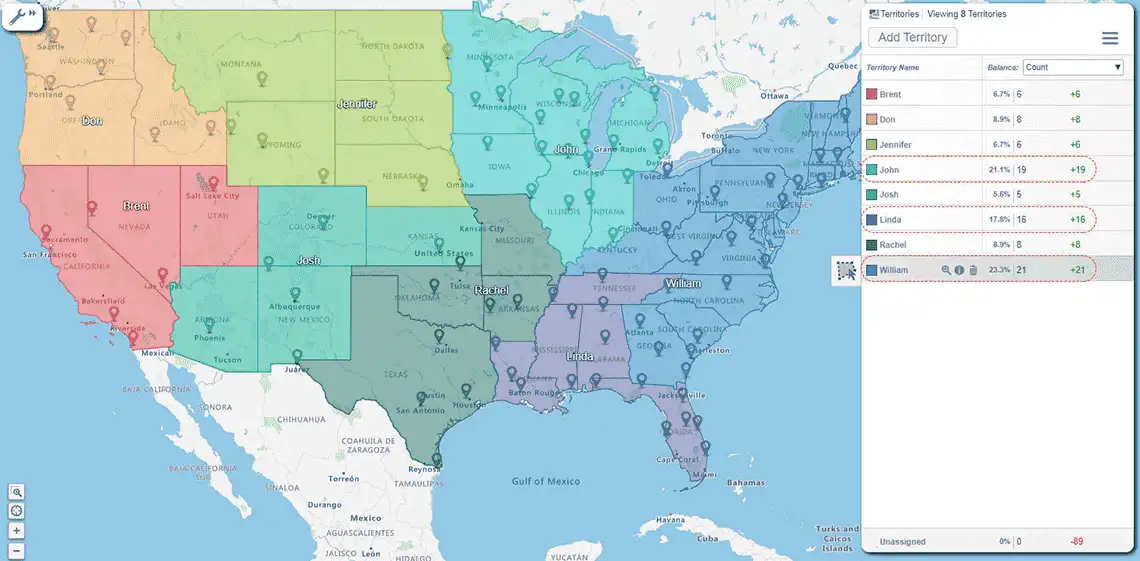Territory management is the engine of your sales strategy. How you create, align, and assign territories directly impacts sales performance. It is not a one-off task; it is an ongoing process vital for capturing leads and converting sales in a fast-changing environment.
What is Territory Management in Sales?
It is the process of dividing sales territories among representatives to maximize sales potential>.
This system allows reps to focus solely on target customers within specific boundaries, boosting their ability to reach more people and drive revenue.
Before you start, be aware of common challenges:
- Uneven sales performance
- Territory gaps and overlaps
- Low team productivity
-
Inefficient resource allocation.
The 3 pillars of territory management
1. Sales territory design
This is the strategic division of a larger market into manageable areas of focus.
- Sales leaders must conduct a thorough market analysis. Examine demographic data, customer profiles, purchasing behaviors, and the competitive landscape.
- The Result: You gain the valuable data needed to make informed management decisions.
2. Sales territory planning
Planning creates the comprehensive action plan to manage territories and hit specific targets.
- The Action: Establish clear territory boundaries.
- The Result: Every sales representative knows exactly where their geographic area of focus begins and ends, eliminating confusion.
Sales territory optimization
Optimization focuses on maximizing efficiency to generate the best revenue and customer satisfaction outcomes.
- The Action: Use territory management software, to analyze and adjust assignments.
- The Result: Territories remain balanced, aligned with organizational goals, and capable of leveraging resources to their full potential.

Why Territory Management Matters?
It's not just about drawing lines on a map. Effective management aligns your team, cuts waste, and drives revenue.
The 4 Key Benefits:
1. Boost Sales
Territories foster collaboration, not cannibalization. When boundaries are clear, reps share best practices and insights to overcome challenges together, rather than fighting over the same leads.
2. Strengthen Customer Relationships
Reps develop deeper connections when they own a specific area. They gain expertise in unique local preferences and challenges, allowing them to offer the customized solutions that build long-term trust.
3. Maximize Productivity
Cut the windshield time. Efficient territories allow reps to plan smarter routes and reduce travel costs.
- The result: Less time on the road, more time invested in high-potential sales activities.
4. Retain Top Talent
Territories give reps a sense of ownership and autonomy. When they have the freedom to develop their own strategies within a defined space, they feel empowered.
- Bottom line: Clear boundaries and fair rewards lead to happier reps and lower turnover.
12 Actions to Optimize Territories
Below we share 12 proven territory management tactics
Combining clean data with mapping software isn't just admin—it is a growth engine that saves time, cuts costs, and drives revenue.
1. Create the master plan
Don't wing it. Follow a 4-step framework before drawing lines:
- Analyze: Assess market data and buying trends
- Segment: Group customers logically
- SWOT: Assess internal/external threats and strengths
- Execute: Combine data with business goals to set clear parameters
Here is our guide to creating your plan and here is a summary:
2. Secure Buy-In Early
Data beats gut feel, but local knowledge is gold. Involve reps early to fine-tune designs and reduce resistance to change.
The fix: Communicate often. Share maps and get real-time feedback on quotas and boundaries.
3. Clean your data
Your plan is only as good as your inputs. Delete duplicates, update old contacts, and audit regularly. If the data is dirty, the decisions are dangerous.
4. Pick your priority
Align territories with your specific business priority. Is it revenue growth? Cost reduction? Rep retention? Design for that outcome.
5. Balance the workload
Ensure every rep has enough opportunity to hit quota, but not so much they can't service the accounts.
Why it matters: Balanced workloads prevent burnout and ensure no customer is neglected.
6. Align Resources to Opportunity
Stop wasting miles and effort. Move reps to where the revenue is. This cuts the cost of sales while driving growth.
7. Set Quotas Based on Potential
Don't punish hard work with bad geography. Adjust quotas to reflect the actual sales potential of a region. Ensure the game is winnable for everyone.
8. Customer Obsession
Balanced territories mean reps have the time to nurture relationships.
The result: More upsells, renewals, and happier clients.
9. Cut the Commute
Optimize routes to reduce "windshield time." Less driving means more meetings, lower fuel costs, and a smaller carbon footprint.
10. Stop burnout
Unfair workloads are a leading cause of employee turnover. Fair distribution of opportunity is the best retention bonus you can offer.
A Gallup survey found that 76% of US workers reported experiencing burnout.
11. Iterate, Don't Set and Forget
Markets move. Promotions happen. Review territory alignments annually (at a minimum) to keep pace with reality.
12. Scale up
Once you've mastered territory optimization use the data to identify new high-potential markets and carve out fresh territories for expansion.
Frequently Asked Questions
What is Sales Territory Management?
It is the strategic process of dividing a market among sales teams to maximize resources and revenue. Instead of a free-for-all, reps focus on specific targets within defined boundaries.
Why is Territory Management Important?
It creates efficiency and fairness. Proper management ensures reps have enough opportunity to hit quota without being overworked , while the company reduces travel costs ("windshield time") and increases coverage.
How Often Should I Review Sales Territories?
At least annually. Markets are dynamic. Internal promotions, customer turnover, and competitor activity require you to adjust your alignments regularly to stay efficient.
What is the Biggest Mistake in Territory Planning?
Relying on gut feel over data. Successful plans require clean data and a thorough market analysis. Without data, you risk creating unbalanced territories that demoralize staff.
How Does Territory Management Reduce Burnout?
It prevents unfair workloads. By balancing sales potential across regions, you ensure no rep is tasked with an unachievable goal, which is a leading cause of employee turnover.

